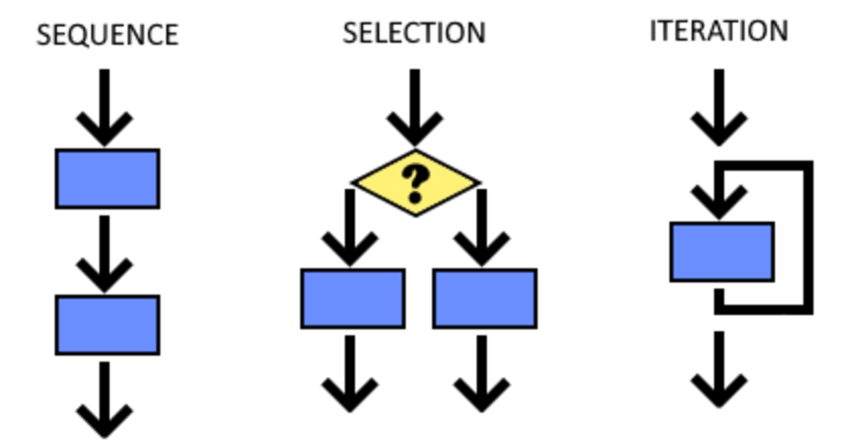Navigating the Code Flow: A Comprehensive Exploration of Sequences, Selections, and Loops in Programming

Introduction:
In the intricate realm of programming, the orchestration of logic and control forms the backbone of software development. Sequences, selections, and loops are fundamental constructs that govern the flow of code, allowing developers to create dynamic, responsive, and efficient applications. In this extensive exploration, we delve into the nuances of these constructs, unraveling their roles, implementations, and the pivotal contributions they make to the fabric of programming languages.
- Sequences: The Linear Dance of Execution
At its simplest form, programming often involves the execution of instructions in a sequential manner. Sequences represent the linear progression of code, where statements are executed one after another. This fundamental concept underlies the logic of a program, defining the order in which operations are performed.
Sequences are the building blocks upon which more complex functionalities are constructed. Whether initializing variables, performing calculations, or invoking functions, the ordered execution of code within a sequence lays the groundwork for the logical flow of a program.
# Example of a sequence in Python
name = "John"
age = 25
print("Hello, " + name + "! You are " + str(age) + " years old.")
- Selections: The Decision-Making Interlude
While sequences provide the foundation, selections introduce the element of decision-making to code execution. Selection structures, often realized through conditional statements, allow a program to choose between different paths based on specified conditions.
Common forms of selection structures include if statements, switch statements, and ternary operators. These constructs empower developers to create responsive code, where the program dynamically adjusts its course of action based on the values and states encountered during execution.
// Example of a selection (if statement) in JavaScript
let temperature = 28;if (temperature > 30) {
console.log("It's a hot day!");
} else if (temperature < 10) {
console.log("It's a cold day!");
} else {
console.log("The weather is moderate.");
}
- Loops: The Repetitive Rhythm of Iteration
In the symphony of programming, loops introduce the concept of iteration, allowing a set of instructions to be repeated multiple times. Loops are invaluable for automating repetitive tasks, iterating through data structures, and implementing dynamic algorithms.
Common types of loops include for loops, while loops, and do-while loops. These constructs empower developers to create efficient, scalable, and flexible code that can handle varying amounts of data or execute specific tasks until certain conditions are met.
# Example of a loop (for loop) in Python
for i in range(5):
print("Iteration", i)
- Combining Constructs: The Harmonious Composition
The true power of programming emerges when these fundamental constructs—sequences, selections, and loops—are combined to create intricate algorithms and robust applications. A well-crafted program seamlessly integrates these elements, orchestrating a dance of sequences, making decisions through selections, and executing repetitive tasks with loops.
// Example combining sequences, selections, and loops (Java)
for (int i = 1; i <= 5; i++) {
if (i % 2 == 0) {
System.out.println("Even number: " + i);
} else {
System.out.println("Odd number: " + i);
}
}
- Algorithmic Complexity: Balancing Act of Efficiency
Understanding when to deploy sequences, selections, and loops is crucial for managing the algorithmic complexity of a program. Asymptotic analysis, Big O notation, and algorithmic efficiency become guiding principles as developers strive to strike a balance between readability, maintainability, and optimal performance.
Selection of the most appropriate construct depends on the nature of the problem being solved. For example, a program handling a large dataset might benefit from an efficient loop, while a decision-making process could be elegantly expressed through selection structures.
// Example combining sequences, selections, and loops (C#)
int[] numbers = { 2, 7, 5, 9, 3, 8 };foreach (var number in numbers)
{
if (number % 2 == 0)
{
Console.WriteLine("Even number: " + number);
}
else
{
Console.WriteLine("Odd number: " + number);
}
}
- Programming Paradigms and Constructs: Beyond the Basics
As programming languages evolve, various paradigms bring forth new constructs that build upon or transcend the basics of sequences, selections, and loops. Object-oriented programming introduces concepts like classes and inheritance, functional programming emphasizes immutability and higher-order functions, and concurrent programming introduces constructs for parallel execution.
Understanding and embracing these paradigms extends a programmer’s toolkit, enabling them to address diverse challenges and harness the expressive power of different language features.
Conclusion:
In the intricate dance of programming, sequences, selections, and loops serve as the choreography that guides the execution of code. From the linear progression of sequences to the decision-making capabilities of selections and the repetitive rhythm of loops, these constructs underpin the logic and control flow of every software application.
A nuanced understanding of when and how to employ these constructs is essential for crafting efficient, readable, and maintainable code. As developers navigate the complexities of algorithm design, they draw upon the rich palette of sequences, selections, and loops to create digital symphonies that power the technology shaping our interconnected world. In this ever-evolving landscape, the mastery of these fundamental constructs becomes not only a skill but an art form, allowing programmers to craft elegant solutions and navigate the intricate landscapes of the digital domain.




